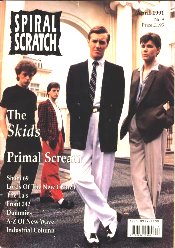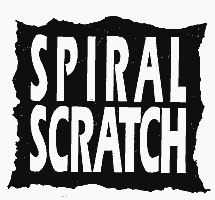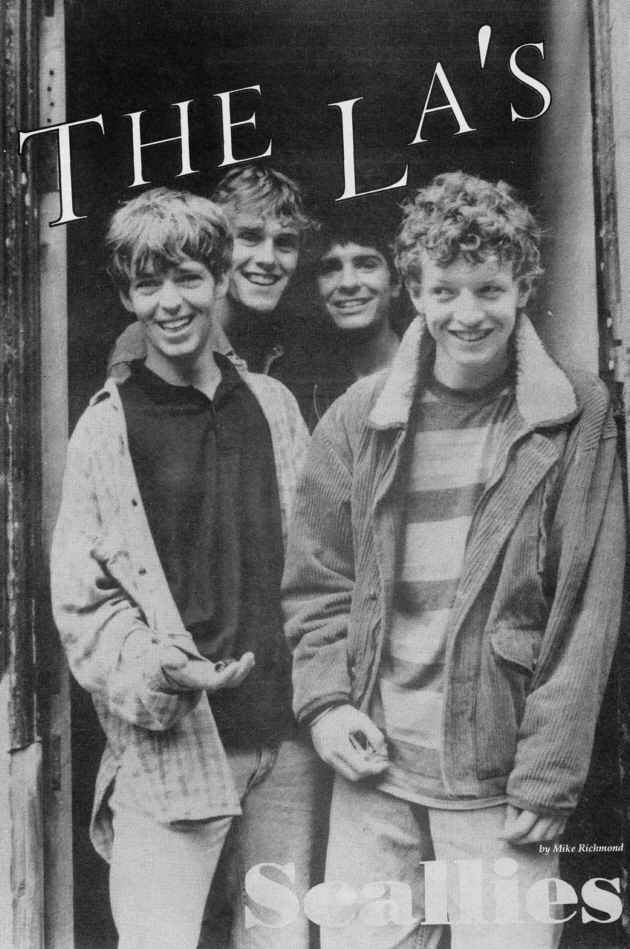 |

Spiral Scratch magazine stopped in the early 90's, it tended to
lean towards New Wave, Punk.. and seemingly, an obligatory article on the
Sex Pistols in every issue! ...
|
PUBLICATION - SPIRAL SCRATCH
ORIGIN - UK
DATE OF PUBLICATION - April 1991
SUBJECT - The La's
TITLE - ' Scallies '
AUTHOR - Mike Richmond
INPUT - Phil Smith, David Evans, Go! Discs
CONTENT - Band history ( up to April 1991.. )
UK discography.

One of a series of postcards given away with
the following releases.
There She Goes 7" GO! DISCS GOLAB 5 &
Feelin' 7" GO! DISCS GOLAB 6
used here as the opening page for the article.
Pictures - (or lack of.. ) The Spiral Scratch
piece had photos, nothing original though, just the
' postcard ' pictures used widely for any
article or interview mentioning The La's, the quality of the paper means
that the pictures are rather muddy, so, I've decided not to use them.
The La's are a rare breed. In an age of techno
bleeps and fringes, dance raves and flares, The La's stand alone. Like
their fellow Liverpudlians, The Farm, they've recently had chart success
after being around for five or six years. Unlike The Farm they've kept
their own style intact without adapting to the current Indie/Dance cross-over
scene.
The La's were originally formed way back in
'84 by a chap named Mike Badger, a singer and a guitarist, was a James
Dean look-a-like from Liverpool who was engrossed by the R'n'B sounds of
the fifties and sixties. The name he chose for the group came from the
scouse expression "La", short for "lad". It was also an obvious musical
term.
Before he could find any regular La's, a chance
to appear on a local compilation album cropped up. Badger employed session
musicians to record I Don't Like Hanging Around at The Chemist Studio in
Liverpool. The Subsequent album was entitled A Secret Liverpool and is
now virtually impossible to find in its original format. Released by local
entrepreneur Carl Davies,500 one sided albums were pressed up and sold
with brown cardboard sleeves, the idea was that the listener would like
the record and then would pay for a second pressing, consisting of side
2 and the proper sleeve. The second pressing later became a proper 2-sided
album with gatefold sleeve and inserts. 1000 of which were pressed.
Lee Mavers joined the group soon after, He
had previously played bass in Neuklon, a rock-a-billy outfit, complete
with quiffs! A drummer, Tony Russell and a bassist were recruited and they
soon started playing parties and local pubs.
Another compilation album soon followed, Elegance,
Charm & Deadly Danger, was released on the St Helens' Arts-funded Push
Label. 1500 copies were pressed, each including a free booklet with contributions
from the various groups . Two tracks came from The La's, the slow bluesy
Sweet 35 and the more raucous My Girl (Sits Like A Reindeer), which owed
more to the later La's sound. This was Lee Mavers' first appearance on
vynil, although Mike Badger alone appears on the sleeve photo. Also My
Girl has an uncanny similarity to the recent La's single, Feelin'.
The group were getting more popular locally
after securing a residency at the Why Not? club in Liverpool and really
started gaining a following after playing Monroe's, a pub in Liverpool
where many small acts were to start out, which also employed extremely
liberal licensing hours. The group drew a so called 'scally' crowd, mainly
due to their own down-to-earth attitude and casual dress sense.
Sack The Boss
More line-up changes occured. David Evans briefly
joined on Bass. He had played in another local outfit, The Riotous Hues.
The biggest change came in '86 when Mavers and Co sacked Mike Badgers.
Mavers had begun writing his own material and obviously wanted a bigger
share of the action. John Power joined on bass, he and Mavers being the
only remaining La's from this period.
With a line-up completed by ex-Twangum Banjo
Paul Hemmings on lead guitar and John Timson on drums, the group set about
securing a record deal. A seven track demo tape was sent out in early '87
and in no time at all the band had signed to Andy McDonald's recently formed
GO! DISCS label, then home of Billy Bragg and The Housemartins.
From their earliest interviews Mavers was keen
to express what The La's meant to him: "Our philosophy is simple, if you
want it, you can get it! And we really believe in our music- really. It's
not about being a musician- and it's not about being a face. It's just
passing a feeling." His influences included the Who, James Brown, the more
obvious Beatles,and the Stones. He also cites the band's ability to convey
their "feeling" through the rhythm in their playing.
In October '87 their first single, Way Out,
was released. A mid-tempo waltz, it wasn't their
best song but was a good start nonetheless.
Backed by the more sixties influenced Endless
complete with sitar-sounding guitar, it recieved
rave reviews from the music press. A limited 12" featuring two exclusive
demo tracks is proving scarce although 5000 were pressed.
Way Out sets the scene for The La's sound.
Mavers sings and plays rhythm guitar while the lead guitar fleshes out
the melody. They always record a track how they would play it live, with
little or no overdubs, and Mavers as sole songwriter writes excellent ballads
as well as the more obvious pop songs.
Going Back To Liverpool
The group moved down to Hammersmith in London
to be near to the GO! DISCS HQ but this didn't work out. After complaints
from their neighbours and the police who wereseemingly around all the time,
they returned to Liverpool after just three months.
More line-up changes occured, Paul Hemmings
later going on to play with Mike Badger in his current group, The
Onset. Eventually, a more stable line-up was achieved with Barry Sutton,
formerly Marshmallow Overcoat and Walking Seeds, on lead guitar and Chris
Shamrock on drums.
In October '88, The La's best single to date,
There She Goes was released. "Classic" is a word that is used far too often
in the music world, but this track is worthy of greater praise. An immediately
catchy riff leads into an even greater chorus, one listen and you're still
humming it a week later! Although given a great response by the reviewers,
it failed somehow to become the smash hit it deserved to be, something
the band put down to poor distribution. Another limited edition was released
- this time a four track 7" EP featuring different versions from those
previously released.
For the last time there is a change of personnel.
Both Sutton and Shamrock are replaced by Peter Camell ("Cammy") and Neil
Mavers (Lee's brother). Both were ex-La's roadies who replaced their counterparts
when they jumped onstage at a soundcheck, proving they were better than
the unfortunate pair who had just nipped to the loo! Shamrock now plays
drums in World Party.
Next, the band wanted to record an album. They
decided to take a small advance and record it as quickly and as cheaply
as possible. But they soon found out it wasn't that simple. They had a
problem capturing the sound they were looking for. Producers were hired
and fired, before, finally, Mike Hedges was employed to produce the album.
The first attempt was rejected and then retried at Hedges own studio in
Devon. After further problems the band even tried to reconstruct some of
Abbey Road's old recording gear, to no avail.
Unreleased Melody
A new single was scheduled for release in February
'89. Timeless Melody, another powerful piece of pop concerning Mavers'
own love of music was never released. Although around 500 12" promos and
ten 7" test pressings exist it was withdrawn at the last minute without
explanation. This is now a highly sought after rarity.
Things looked more positive when Mike Hedges
was replaced by Steve Lillywhite as the new producer. Although a strange
pairing, (Lillywhite being more associated with the stadium rock sound
of U2 and Simple Minds) both parties hit it off and sessions resumed for
the album with a provisional release date set for early '89. Then it became
early '90. Then things got a little confusing...
According to GO! DISCS, the band walked out
on the album, but were nevertheless still confident that they could finish
it all off. Andy McDonald invited Mavers to the lenghty mixing and production
process, but Mavers refused. And so Lillywhite again remixed and produced
the final album. GO! DISCS also maintain that they tried every studio technique
the band requested: 4-track, 8-track, etc, that seven studios were used,
umpteen producers, all of which cost a lot of money. They felt it was finally
time to bring the songs to life.
According to The La's, they walked out on the
album for good. GO! DISCS and Lillywhite produced a duff album using the
wrong vocal tracks , changed the title, (originally to be called Callin'
All), the cover art and the track-listing. The bands own qualm was their
continuing inability to capture their "organic" sound in the recording
studio. This "sound" can actually be heard on Over, on the 12" of the resurrected
Timeless Melody. Recorded on a normal tape recorder in a barn in Liverpool,
it's a raw and honest sound, but of a quality that no major company would
want to release as an album.
When the eponymously titled album finally hit
the shops in November '90, it received wildly ecstatic reviews. For all
the talk of bad production , I found it both raw yet uncluttered, but also
sounding as if it had been recorded in a matter of hours. It sounds remarkably
faithful to their live sound. The only thing not in its favour is its lenght,
clocking in at only 35 minutes. The songs sparkle with variety from the
obvious tracks to the military -style Freedom Song and to the epic album
closer, Looking Glass, a spaced out jam session. What is noticeable is
Mavers' voice, much rougher than before, especially when comparing the
original and new version of Way Out. The album has since gone Silver in
the UK, selling over 60,000 copies.
As mentioned before, Timeless Melody was reissued
as a single before the album's release, Although not a major hit, it featured
the first of the distinctive Ryan Art "eye" sleeve designs. There was no
limited edition released but it's worth noting that each format came in
a different coloured sleeve.
The Ryan Art "eye" sleeve designs that graced
several La's covers.
Above the 3 different sleeves for the August
1990 release of Timeless Melody.
Left to right, 7" inch, 12" inch, and finally..
compact disc.
A remixed There She Goes changed the band's
fortunes in October '90 with a Top 20 chart hit and an appearance on Top
of The Pops. A limited edition box set with free stickers and a badge was
issued and is already proving scarce. 12" promos are worth noting, coming
with the prefix LASDJ, and with their own unique labels. Usually only a
thousand of each is pressed. Similarly there is The La's Sound Sampler*,
a CD promo-only featuring five tracks from the album, also with a unique
sleeve and a thousand pressing.
*Said to have slightly different mixes,
'slight' being the correct word..
The La's toured Europe with World Party in
October, cut short when John Power injured his hand, and played their own
UK tour in November.
Feelin', the most recent single was issued
in January this year. Again a box set was available, featuring an alternate
version of the song, exclusive to this format. More touring followed, supported
by the Milltown Brothers. By now, The La's should have finished building
their own 8-track studio in their hometown of Liverpool. It is here that
they hope to record their future releases.
While most bands knock out their debut album
in a matter of months and then have a problem with the follow-up, I hope
The La's can do the reverse and give us some new material. Besides, if
Lee Mavers thinks it's a bad album I'd love to hear a good one.
Or else, The La's could become one of Lee Mavers
favourite bands: the who???
Callin' All
Thanks to Phil Smith, David Evans and GO! DISCS
for their help.
Author - Mike Richmond.

|